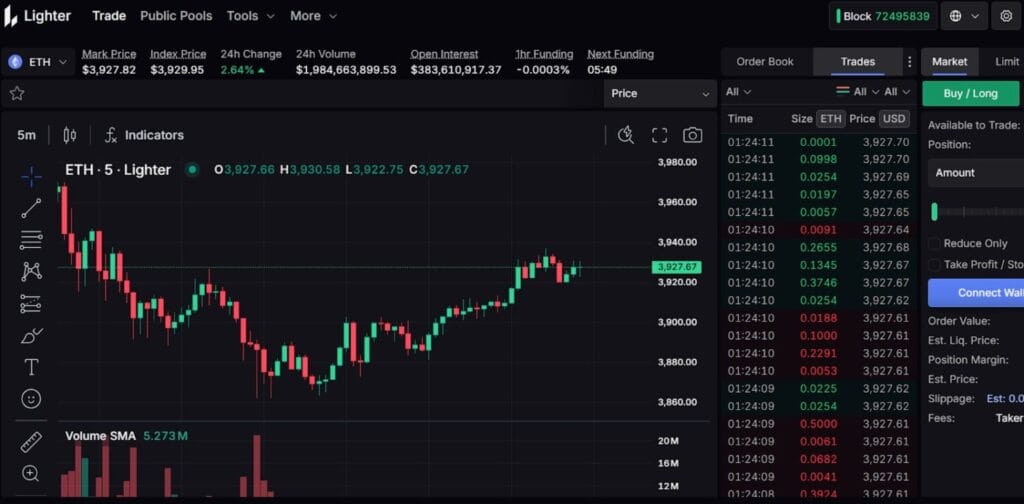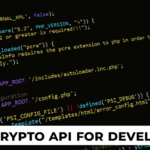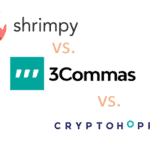This review breaks down Lighter, a decentralized, zero-fee (Standard) perpetuals exchange that blends CEX-style speed with on-chain verifiability. In this article, we will dive deep in Lighter Review.
Table of Contents
What is Lighter?
Lighter is a decentralized trading platform for perpetual futures built for high security and massive scale. It’s the first exchange to make order matching and liquidations verifiable with cryptography while still delivering performance comparable to traditional exchanges. You trade from your own wallet; the system proves that matching, pricing, and risk steps were executed correctly.

Lighter Review: How to Get Started
- Wallet & funds: Use a supported wallet; keep USDC for collateral and a little ETH for gas.
- Open the app: Connect your wallet and pick Standard to start fee-free.
- Place a limit order: Start small; use Post-Only if you want maker behavior and Reduce-Only for exits.
- Set protection: Add Stop-Loss and Take-Profit right after entry; consider GTT expiries.
- Scale with tools: For larger trades, try TWAP to reduce impact; watch IMR/MMR/CMR and the mark price.
Features & Products
- Account types & fees: Standard (default) has 0% maker/0% taker, ~300 ms taker and ~200 ms maker/cancel latency; Premium (opt-in) has 0.002% maker/0.02% taker, 0 ms maker/cancel and 150 ms taker latency for HFT.
- Markets & specs: Perpetual futures on the test network with governance adding pairs over time; each market defines IMR/MMR/CMR to control leverage limits and liquidation thresholds.

- Order types & execution controls: Market (with average-price cap) and Limit orders; Post-Only guarantees maker behavior, Reduce-Only ensures orders only shrink positions (extra size auto-cancels).
- Time-in-Force (TIF): Good ’Til Time (GTT) keeps orders live until expiry, then auto-cancels; Immediate-or-Cancel (IOC) fills instantly or cancels the remainder (never rests on the book).
- Stops & targets (SL/TP): Market and Limit versions; triggers use markPrice ≤ trigger (SL sell/TP buy) or markPrice ≥ trigger (SL buy/TP sell); SL/TP limits also support GTT and Reduce-Only.
- TWAP execution: Splits a large trade into slices every 30 s over a chosen duration; number of slices = duration/30 s + 1; optional Reduce-Only makes each child order de-risk the position.
- Price integrity & matching: Fat-finger checks bound order prices (asks ≥ max(mark, bestBid)×0.95; bids ≤ min(mark, bestAsk)×1.05); matching is price-time priority, and STP cancels self-matches.
- Pricing, PnL & special markets: Mark Price blends order-book liquidity with the index price; Unrealized/Realized PnL update continuously; RWA & prelaunch markets are isolated-only, use XLP liquidity, charge no liquidation fee, and follow IOC-then-ADL when margin falls below thresholds.

- Use Testnet to practice wallets, order types (SL/TP, TWAP, Post-/Reduce-Only), and risk flows without real funds—ideal for onboarding referrals. Points eligibility on Testnet depends on official announcements; assume mainnet unless stated.

Security
- Verifiable core: Matching, pricing, and liquidation logic produce cryptographic proofs that can be checked on Ethereum. This “trust-but-verify” model lets you confirm the engine followed the rules—not just take anyone’s word for it.
- Guardrails by default: Protective checks catch bad inputs and extreme prices, fair price marking anchors risk to a sensible reference, and tiered IMR/MMR/CMR margins define clear thresholds for warnings, liquidations, and close-out behavior.
- STP baked in: Self-Trade Prevention blocks your orders from filling against each other, avoiding positionless churn, unnecessary fees, and confusing PnL. The resting maker side is canceled automatically when a self-match occurs.
- Transparent risk handling: Liquidations aim to be partial first to reduce stress on accounts and markets; insurance/ADL mechanisms exist as backstops. You can monitor mark price, margin, and account value in real time to stay ahead of risk.
- Audits, monitoring, and non-custody: Smart contracts and core components undergo security reviews; users trade from their own wallets, reducing centralized custody risk. Status pages/explorers help you verify system health before sizing up.
Lighter Review: Affiliate & Referrals
- Two tracks: Points go to Market Makers (Premium only) and Retail traders each week (total pool ≈ 250,000 points).
- MM pool (20% / 50,000 pts): Only Premium accounts earn MM points. LLP counts as a maker for weighting, but doesn’t keep points—its share is redistributed so totals still equal 250k.
- Maker volume points (Premium): Weekly score = volume + max(0, (volume − 2.5B) × 0.25). Points are split proportionally to score (one weekly calc; all markets equal for this piece).
- Liquidity-quality points (Premium): Random snapshots reward your share of depth ($10k…$30M tiers) and tightness (within 1–10 bps). Market weights update hourly to favor high-demand/risk markets (BTC/ETH/SOL, promising alts).
- Volatility multiplier & daily cap: Volatile snapshots are worth more, but a ceiling prevents one day from dominating (each day ≥ 8.33% of weekly liquidity points).
- Retail pool (200,000 pts/wk): Paid Fridays for Wed→Tue activity. Metrics include Volume, OI, Funding, Liquidations/ADL, PnL, with quality scaling. Not linear and markets aren’t equal (e.g., $100 on BTC ≠ $100 on HYPE).
- Premium influence: Some retail metrics may weigh Premium activity more (e.g., PnL), but Premium is required only for MM points.
- Anti-sybil & fairness: Automated/semi-automated checks; up to 10 accounts/user allowed; self-trade prevention enforced; intentional losses/liquidations don’t help.
Lighter Review: Fees & Pricing
- Standard accounts: Pay 0% maker / 0% taker across markets. You still cover normal network (gas) fees for placing/canceling orders and settling trades.
- Premium accounts: Designed for low latency (0 ms maker/cancel; 150 ms taker). Fees are 0.002% maker / 0.02% taker, and activity can count toward Lighter’s volume-quota program.
- How fees apply: Maker/taker fees are charged on the filled notional. Using Post-Only guarantees maker behavior (and maker fees), while crossing the book makes you a taker.
- Other costs to consider: Funding payments (not a fee) accrue between longs/shorts on perps; net PnL includes funding. Network gas varies with congestion—batch actions when possible to reduce costs.
- Special markets: RWA and pre-launch markets charge no liquidation fee. Liquidations there use IOC closes above close-out margin and ADL below it, with isolated margin and XLP providing liquidity.
Data analytics and Performance
- Lighter’s ecosystem shows exceptional activity, generating over $13.6B in daily volume, reflecting strong market demand, deep liquidity, and sustained engagement across a rapidly expanding user base throughout 2025.
- With $1.18B in TVL and 448,199 distinct depositors, Lighter demonstrates widespread adoption, consistent capital inflows, and growing trust in its infrastructure as a scalable liquidity and trading layer.
- The platform processes more than 11.6 million daily trades across 105 trading pairs, highlighting unmatched throughput, diverse asset coverage, and high-frequency participation from both retail and professional market participants.
- Charts show powerful upward momentum in volume and flow, with sharp acceleration mid-2025, indicating strengthening market confidence, increasing capital utilization, and sustained growth in ecosystem activity.
- Token-level data reveals concentrated trading activity in assets like OG, DOT, and MET, demonstrating diversified liquidity distribution and strong cross-asset participation that reinforces Lighter’s role as a high-performance trading hub.

User Interface & Experience
- Familiar trading layout: You get a classic CEX-style workspace—order book, price chart, order ticket, open positions, fills, and margin/PNL panels—so most traders can navigate without a learning curve.
- Clear, protective controls: Reduce-Only, Post-Only, GTT/IOC, and built-in SL/TP and TWAP live right on the ticket, with plain prompts that explain exactly what each toggle will do before you submit.
- Real-time safeguards: Mark price, average-price caps for market orders, and fat-finger checks surface in the flow to minimize accidental slippage or out-of-range orders on thinner books.
- Readable risk at a glance: IMR/MMR/CMR thresholds, funding timers, and liquidation distance are visible beside your positions so you can size, hedge, or trim before conditions worsen.
- Fast feedback & states: If a quote updates mid-submit, the UI asks you to accept the change; partial-fill notices and cancel/replace flows are quick, keeping you in control during volatile moments.

Lighter Review: Mobile App
- Mobile-friendly web experience: Trade from your phone’s browser—no separate iOS/Android install needed. Connect a mobile wallet directly or via WalletConnect for on-the-go entries and exits.
- Optimized ticket & charts: The interface prioritizes the ticket, mark price, and position readouts on small screens, with quick switches between markets and order types.
- Low-friction actions: One-tap Reduce-Only, easy SL/TP attachment after fill, and fast cancel/replace help you manage risk without desktop precision.
- Best practices on mobile: Keep a small gas balance, confirm network, and run a tiny test order after updates; use biometric/PIN wallet locks to prevent accidental orders.

Customer Support
- Self-help first: Most questions are answered in the official Docs/FAQ. They’re searchable and kept up to date—great for quick fixes, feature details, and step-by-step guides.
- Community help: Join the official Telegram, Discord, and Twitter (X) channels for announcements, tips from other traders, and fast responses from moderators.
- Report an issue: When you contact support or post in channels, include your wallet address, order/tx hash, device + browser/app version, time of the issue, and screenshots. That speeds up troubleshooting.
- Safety check: Always use links from the official docs or pinned posts to avoid impostors. Never share seed phrases or private keys—support will never ask for them.

Lighter Review: Conclusion
Lighter blends exchange-grade performance with on-chain verifiability. Retail traders get zero-fee Standard accounts and clear controls; pros can opt into Premium for ultra-low latency. With robust order types, strict price checks, and explicit margin tiers—plus experimental RWA and pre-launch markets—Lighter offers powerful tools without sacrificing safety rails. Start small, use Reduce-Only and SL/TP, and scale only after you understand IMR/MMR/CMR behavior.
Frequently Asked Questions
Can I cap slippage on market orders?
Why did my SL/TP not trigger?
SL/TP relies on the mark price relative to your trigger price. Check the trigger direction and confirm you used markPrice ≤/≥ triggerPrice correctly for the order type.
Do self-trades ever execute?
No. STP cancels the resting maker side to prevent self-fills, avoiding pointless fees and position churn.







